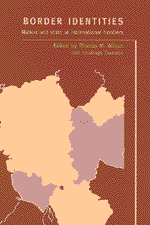Book contents
- Frontmatter
- Contents
- List of maps
- List of contributors
- Acknowledgements
- 1 Nation, state and identity at international borders
- 2 State formation and national identity in the Catalan borderlands during the eighteenth and nineteenth centuries
- 3 A western perspective on an eastern interpretation of where north meets south: Pyrenean borderland cultures
- 4 The ‘new immigration’ and the transformation of the European-African frontier
- 5 Transnationalism in California and Mexico at the end of empire
- 6 National identity on the frontier: Palestinians in the Israeli education system
- 7 Grenzregime (border regime): the Wall and its aftermath
- 8 Transcending the state? gender and borderline constructions of citizenship in Zimbabwe
- 9 Borders, boundaries, tradition and state on the Malaysian periphery
- 10 Markets, morality and modernity in north-east Turkey
- 11 Imagining ‘the South’: hybridity, heterotopias and Arabesk on the Turkish–Syrian border
- Author index
- Subject index
4 - The ‘new immigration’ and the transformation of the European-African frontier
Published online by Cambridge University Press: 02 December 2009
- Frontmatter
- Contents
- List of maps
- List of contributors
- Acknowledgements
- 1 Nation, state and identity at international borders
- 2 State formation and national identity in the Catalan borderlands during the eighteenth and nineteenth centuries
- 3 A western perspective on an eastern interpretation of where north meets south: Pyrenean borderland cultures
- 4 The ‘new immigration’ and the transformation of the European-African frontier
- 5 Transnationalism in California and Mexico at the end of empire
- 6 National identity on the frontier: Palestinians in the Israeli education system
- 7 Grenzregime (border regime): the Wall and its aftermath
- 8 Transcending the state? gender and borderline constructions of citizenship in Zimbabwe
- 9 Borders, boundaries, tradition and state on the Malaysian periphery
- 10 Markets, morality and modernity in north-east Turkey
- 11 Imagining ‘the South’: hybridity, heterotopias and Arabesk on the Turkish–Syrian border
- Author index
- Subject index
Summary
Introduction
In the past decade much has been written about the transformations of European frontiers. Much of this discussion has focused on the internal borders of the European Union, with rather less attention being given to its external boundaries. In many countries of Europe, however, it is precisely at these external boundaries that a sense of Europeanness is most visibly expressed and challenged. Thus, the celebration of ‘1992’ in Spain was suffused with meaning, which sensitised people to many aspects of their national and regional identities. It made boundary problems manifest in many different ways, including the Basque and Catalan ethnonationalisms discussed by Sahlins and Douglass (this volume). Not only was ‘1992’ a powerful symbol of European integration, in particular the projected date of the completion of the single European market promoted by Euro-politicians and the mass media, but it also referred to the commemoration of the ‘discovery’ of America, the celebration of the World Exhibition in Seville, the Olympic Games in Barcelona, the remembrance of the fall in 1492 of the Muslim kingdom of Granada, and the expulsion of the Jews from Spain. The Christian reconquest of Granada completely altered the political and cultural map of the Mediterranean world. The expulsion of the Jews and Moriscos became one of the largest ‘ethno-religious cleansing’ operations avant-la-lettre in early-modern Europe.
- Type
- Chapter
- Information
- Border IdentitiesNation and State at International Frontiers, pp. 96 - 116Publisher: Cambridge University PressPrint publication year: 1998
- 12
- Cited by



